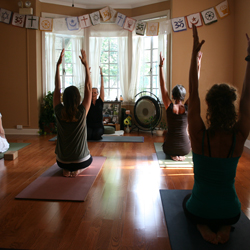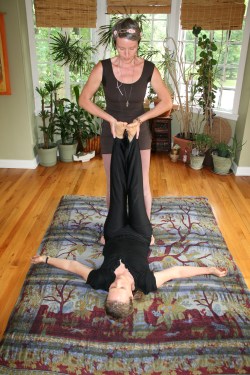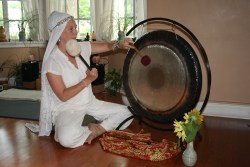At Heading OM Yoga, healing is for everyone.
As they lie on mats preparing for their Restorative Yoga class, the students chat about the benefits of attending regular sessions. One suffers from fibromyalgia, another from arthritis, and they discuss how the ancient practice improves their mobility. A young woman stretches, hoping it will help with her flexibility and strength. Another sits cross-legged, collecting her thoughts before the lesson.
The Sanskrit word yoga translates to “yoke” or “union,” referring to the union between the physical body, mind and spirit. In recent decades, yoga has become a fitness phenomenon, having grown into a $27-billion industry. But it’s also a spiritual practice—a rich and diverse one—with many different traditions and methods.
While fitness-based yoga classes can be found at just about any gym, Heading OM Yoga in West Peoria offers a range of unique practices and holistic health classes to complement anyone’s routine, whether for health and wellness, spiritual purposes or both. From aging baby boomers to expecting mothers and beyond, people of all ages and skill levels can reduce stress, build strength and flexibility, and rejuvenate the connection between body, mind and spirit.
The Thai Tradition
Heading OM offers a number of sessions based in the Thai tradition—a 2,000-year-old, healing-based practice originating in Indian medicine—including Thai Bodywork, self-care, herbal remedies and meditation. Thai Bodywork is typically an assisted yoga, in which the student lies down while the practitioner leads their body through a variety of poses—inversions, twists and stretches—which help to alleviate stress, realign the body, and improve one’s range of motion and energy.
“It’s a deep body awareness,” says Heading OM owner and instructor Tammy Mitchell. “It can be a very deep form of meditation.” Mitchell recommends Thai Bodywork to people who experience chronic pain, such as those with MS or fibromyalgia, but these sessions can benefit everyone, whether by increasing body awareness or simply aiding in relaxation.
 Heading OM offers group classes in Thai Restorative Yoga and Thai Partner Basics, as well as individual sessions that offer the special attention a group class simply cannot. “In a group class, the lesson comes from the instructor to a big group of people who might be at many different levels of… experience in their lives,” Mitchell explains. “When you’re working one-on-one, it’s time to scale things down and hone in on specific practices that are medicine for that person—medicine for that body.”
Heading OM offers group classes in Thai Restorative Yoga and Thai Partner Basics, as well as individual sessions that offer the special attention a group class simply cannot. “In a group class, the lesson comes from the instructor to a big group of people who might be at many different levels of… experience in their lives,” Mitchell explains. “When you’re working one-on-one, it’s time to scale things down and hone in on specific practices that are medicine for that person—medicine for that body.”
When she’s not leading her own classes at Heading OM, instructor Lisa Raabe attends sessions as a student. “I am a practitioner and a client,” she explains. “My experience, number one, is being super-relaxed and allowing movement to [be led] by someone else… There’s something about fluidity—letting go—and experiencing your body in this very relaxed place… [feeling] your energy moving through you.”
Yoga for Baby
In Heading OM’s prenatal yoga classes, instructor Emily Dahlhoff works to create an environment that educates, supports and challenges expecting mothers. She incorporates exercises they can take into the labor room, from various breathing techniques to “contraction practice,” in which students perform an exercise such as a wall squat, and learn to breathe through the discomfort of the birthing process. “I try to challenge my students because contractions don’t stop,” she says. “You have to learn to breathe through the contractions and be calm.”
With an emphasis on the mother’s physical health during pregnancy, Dahlhoff’s primary intention is to create a calm, comforting environment in the studio. “I say to them, ‘This is your quiet space, just for you and your baby.’ I hold a safe space for them to take a deep breath, let go and be present with themselves.”
As they engage in discussions about the “amazing journey of motherhood,” the students also gain a sense of community from the weekly classes. “I very much encourage community,” says Dahlhoff. “Each class, we introduce ourselves. I ask how many weeks people are. We keep up to date with each other.
“They are getting a little bit of birth education, a little bit of community,” she adds. “The yoga part is really what defines it and makes it different… the fitness end of it, strengthening their core and that sort of thing.”
Unlocking the Energy Inside
At its foundation, yoga not only encompasses the body, breath and mind, but also the spirit or soul. In fact, it originated as a method for reaching spiritual enlightenment, and many people identify spirituality as a vital part of their experience. Yet as the practice has become “westernized,” it can also be enjoyed with no spiritual connection at all. “Spirit is just as individual as the workings of a person’s body,” notes Mitchell.
At Heading OM, Devpreet Kaur specializes in Kundalini yoga, a northern Indian practice thousands of years old that’s preserved its spiritual underpinnings in the modern world. “Kundalini is a Sanskrit word,” says Devpreet. “Kundal means the hair of the lock of the beloved, and the beloved is God.”
As it works to develop and balance the “10 bodies”—the different aspects of a person’s physical, mental and energy being—Kundalini yoga places greater emphasis on meditation than traditional hatha yoga, which is based more in physical movement and fitness. “Meditation is the ultimate experience,” Devpreet declares. “[It] really is a part of all forms of yoga, but because hatha yoga is more of a physical practice, the meditative, spiritual aspects have not been acknowledged as much.”
Devpreet leads early-morning sessions of Kundalini yoga that include meditation, poses, prayers, repetitive movement and chanting to unlock the energies inside and promote balance in body, mind and spirit. “It’s really about taking yoga off the mat, into your life and into the world,” says Devpreet. “Everyone has the right to be healthy, happy and holy.”
 No Quick Fix
No Quick Fix
A professional counselor for 15 years before becoming a full-time yoga instructor, Lisa Raabe’s interest in yoga grew from exploring the relationship between the body and mind. Bringing this knowledge to her classes, she helps to build biomechanical awareness—understanding not only the movement of one’s body, but the reasons for that movement—among her students.
For instance, a student experiencing back pain can learn how their body movements may be creating this pain. She explains that yoga biomechanics differs from the “quick-fix” approach of some therapeutic methods by exploring the purpose behind one’s pain. “I typically think the yoga field is less of a ‘fix-it’ field and more of a finding, exploring and personalizing [method] to find that deep integration for each person.”
Raabe uses this approach in her restorative yoga classes as well as her individual sessions, which can include a three-part muscular assessment of the body. Here, she employs wall ropes as a prop to enhance the work of the body and help her students overcome some of the physical obstacles they might face. A student with shoulder pain, for example, may have trouble with the downward dog pose, but with wall ropes, they can accomplish the pose by simply dangling from the loop as it supports them.
Aligning Movement
Blake McLemore is a licensed massage therapist and certified in myofascial release, a holistic method for treating musculoskeletal pain; and the Anat Baniel Method (ABM) Feldenkrais, a brain-focused, movement-based alternative to physical therapy. For those in need of deep relaxation, McLemore can utilize his massage training, working on the tender, deep tissue, and combine it with bodywork. For clients with more severe pain or neurological issues, such as those with hip or knee replacements or children with cerebral palsy, he is more likely to use ABM or myofascial release.
Developed by psychologist and author Anat Baniel, ABM evolved from the work of Baniel’s mentor, Dr. Moshe Feldenkrais. The ABM method focuses on changing the brain in relation to its function in movement and the healing process. In contrast, the intentions of myofascial release lie more with the body. While physical therapy tends to focus on specific areas of pain, myofascial release treats the whole body, identifying the soft tissue around the muscles and bones that are experiencing trauma. Both methods involve light touches, in contrast with the deep-tissue massage.
“ABM lessons and myofascial release are wonderful complements to yoga because they can really help a person better feel into their body—and make change,” says McLemore. “The lessons can help people have more relaxed tissues and nervous system, so they can continue improving the postures and movements they’ve been practicing.”
 Sound Healing and Beyond
Sound Healing and Beyond
In addition to her Kundalini classes, Devpreet Kaur administers Reiki gong sound healing with a Reiki master, Meredith Bunch. As Devpreet hits the gong gently with a mallet, Bunch applies Reiki to clients, her hands hovering a few inches over the body, cultivating the “life-force energy” around them. The combination of the Reiki energy and the resonation of the gong can help the body heal. “The gong has multiple levels of vibration,” Devpreet says. “People find it very relaxing. The vibrations create an atmosphere where healing can occur. It’s like time becomes suspended.”
Heading OM also offers Ecstatic Dance, a class in which students dance uninhibited, free of judgment or self-consciousness. It begins with participants in a circle, stating their purpose as the music begins to play. “I’m here to dance for happiness,” one says. “I’m here to dance for liberation,” says another. “I’m here to get sweaty,” one shares. Then they dance, in whatever way they feel, until the music stops. “It’s just a free open space,” Mitchell says.
With a multitude of yoga and holistic health options, Heading OM can help anyone achieve a greater connection between body, mind and spirit. “There’s an accessible class for any person, whether you can’t get to the floor, whether you have a knee problem, or you’re super-active,” says Raabe. “It’s an opportunity for a person to feel into their bodies in a brand-new way, to cultivate mindfulness, joy and self-compassion—to nurture yourself.”
“For me, it’s about a balanced lifestyle,” adds Mitchell. “When I’m doing what it is I am here to do, things flow… It’s lots of love given, and lots of love received.” a&s
For more information on Heading OM Yoga, visit headingom.org.


